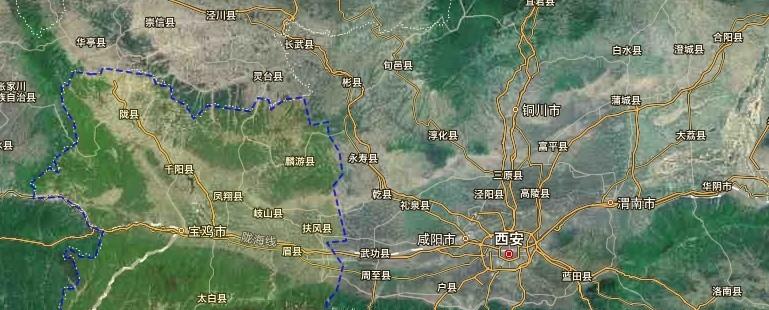When it comes to Shaanxi, we naturally think of Guanzhong. As a very important strategic place in China throughout the ages, Guanzhong has become a place of contention for all parties in almost this long history, and at the same time, it is also the land of Longxing for many dynasties, such as the Han Dynasty and the Tang Dynasty, the two great unified dynasties.

Guanzhong
The reason why it is called Guanzhong, as the name suggests, is that it is in the middle of the Pass. To be precise, Guanzhong means that the entire plain is located in the middle of four passes, which are Xiaoguan in the north, which is located at the Liupanshan Pass to maintain the safety of the northwest of Guanzhong; the Great Scattered Pass in the west, which is the traffic throat between Sichuan and Shaanxi; the Wuguan in the south, which is the main road from Hubei Henan to Shaanxi in ancient times, because it is separated by a Qinling Mountain; as for the east is Hangu Pass, but later evolved into Tongguan, this pass is the most important, is the only key road for Henan and Shanxi to enter Guanzhong, There have been no less than a hundred major wars here, and before Shanhaiguan appeared, it is not an exaggeration to say that it is the first pass in the world.
The four major passes in Guanzhong
Because of this, since ancient times, because of the natural topography advantages of Guanzhong, it is not an easy task to enter Shaanxi from Shanxi or Henan. For example, in ancient Times, Qin Shi Huang defended the Hangu Pass and rejected the Six Kingdoms, and modern Japan fought most of China and even southeast Asia, and did not step into Shaanxi for a long time.
As we all know, after the end of the Battle of Wuhan, China's War of Resistance Against Japanese Aggression officially entered the stage of stalemate. Although the battle ended with the defeat of the Nationalist forces withdrawing from Wuhan and the Japanese army won, the Japanese army did not go further, or had no intention of attacking Chongqing through this route. To this end, the Japanese army decided to start from Shaanxi, in order to learn the wisdom of the ancient Chinese, send troops from Henan, enter Tongguan, and attack Shaanxi, so as to achieve the goal of attacking Sichuan.
The three major lines of defense against the War of Resistance Against Japan
It was in 1941, after the Japanese army had won victory in the early stages of the Pacific War, that it wanted to concentrate its forces on launching the so-called "Battle No. 5" against Shaanxi and Sichuan, the rear of China, in a vain attempt to annihilate the main force of the Chinese army in one fell swoop with a large-scale offensive, destroy the Kuomintang Regime in Chongqing, and force the Chinese Government to surrender.
In fact, in 1938, the Japanese army already had plans to attack Shaanxi. In the spring of 1938, after the Japanese army occupied Yongji in Shanxi, thousands of shells fell to Tongguan every day, and aircraft took turns bombing. However, at that time, the Nationalist 28th Division, 109th Division, 167th Division, 78th Division and 1st Division were stationed at Tongguan, so many Japanese attacks were declared failures.
Chinese territory occupied by the Japanese army during the War of Resistance Against Japanese Aggression
In May 1941, the Battle of Zhongtiao Mountain broke out, but this battle was the most tragic and humiliating military defeat since the Kuomintang War of Resistance. After a month of fighting, the Japanese army still occupied the mountains north of the Yellow River. However, at this juncture, with the victory of the US army at the Battle of Midway and Guadalcanal, the Japanese base camp believed that the US counterattack was imminent, it was necessary to maintain a certain number of troops to be transferred to the Pacific theater at any time, and it was also necessary to maintain the strength of the soviet army in northeast China, so the Japanese army in the Chinese battlefield was unable to attack the Sichuan-Shaanxi region, and the plan to attack Shaanxi was in vain.
Of course, in addition to international reasons, the Chinese battlefield was also extremely unfavorable to the Japanese army. Although the Japanese army won the Battle of Nakajō Mountain, the Nationalist army was still stationed at Nakajō Mountain, and after the Battle of Nakajō Mountain, it was the Base Area of the Eight Roads. This means that if the Japanese army does not eliminate the Chinese troops in Lüliang Zhongtiao Mountain and Henan, the large army crossing the river may be cut off at any time and fall into a heavy siege.
Therefore, it is not that the Japanese army does not want to attack Shaanxi, but it cannot be defeated.